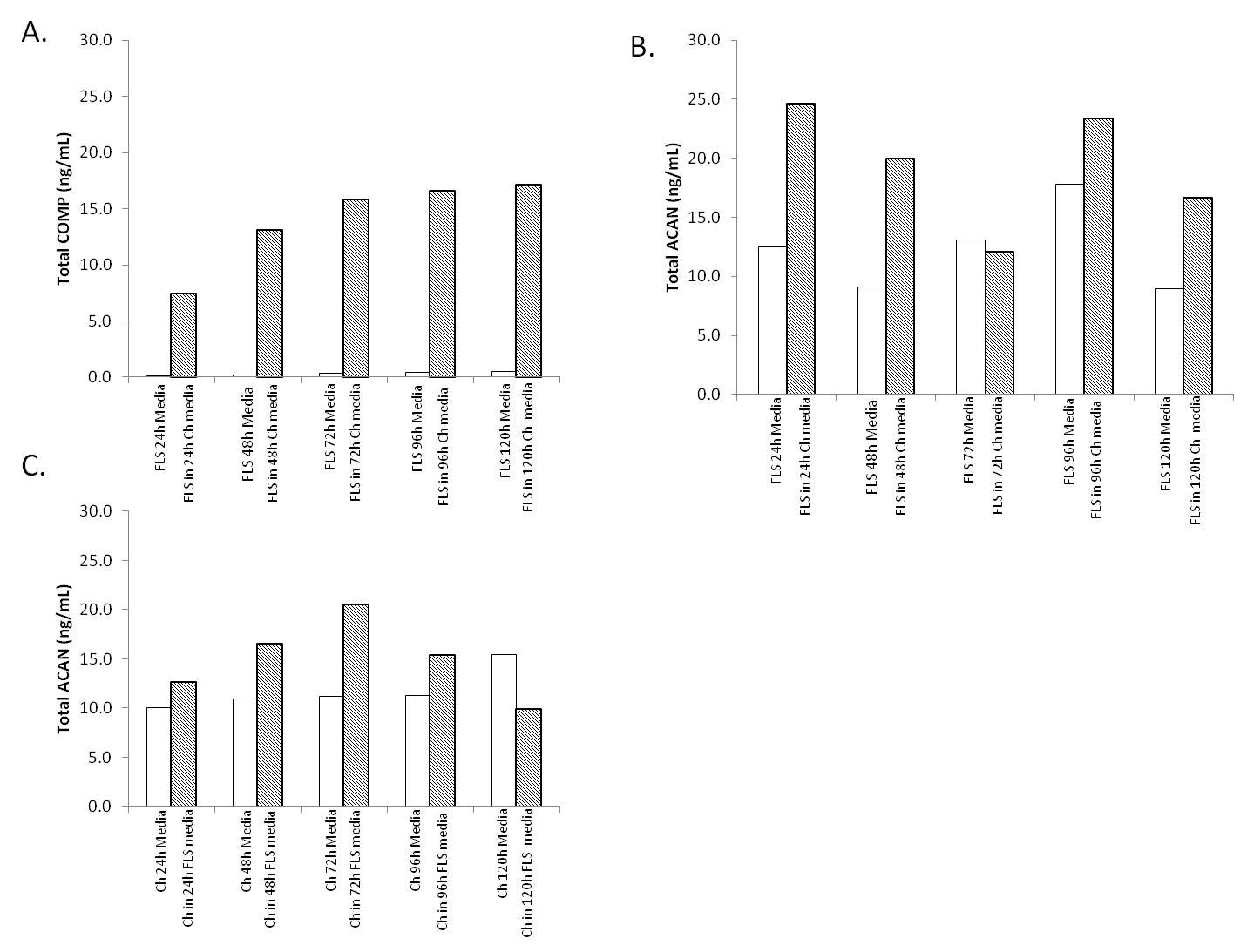Session Information
Session Type: Abstract Submissions
Session Time: 5:30PM-7:00PM
Background/Purpose: A chondrocyte-like phenotype has previously been described in pediatric fibroblast-like synoviocytes (FLS), which may contribute to bony overgrowth in juvenile idiopathic arthritis (JIA). The goal of this project is to study the influence that JIA FLS and chondrocytes (Ch) have on each other along the lines of chondrogenic differentiation.
Methods: As part of a separate ongoing IRB approved protocol, remnant synovial fluid (SF) was obtained from patients undergoing arthrocenteses. FLS were derived from SF of one patient with persistent oligoarticular JIA. Ch were obtained from Cell Applications Inc. Cell media samples were obtained every 24 hours over a five day course from both the JIA FLS and Ch lines. The JIA FLS were then treated for 72 hours with conditioned media from Ch from each of the time points. Conversely, the Ch were treated for 72 hours with conditioned media from JIA FLS from the same time points. Samples were analyzed by ELISA for cartilage oligomeric matrix protein (COMP), aggrecan (ACAN) and type II collagen (CII). Differences in protein levels were compared to the levels secreted by the cultured cell types in 72 hours when exposed to non-conditioned media.
Results: JIA FLS untreated in culture did not produce significant levels of COMP. After 72 hours of exposure to Ch conditioned media, FLS display an increase in COMP production (Figure Panel A). By 72 hours, any COMP contributed by Ch into the conditioned media would be negligible (COMP half-life = approximately 7 hours). Conversely when Ch were treated with FLS conditioned media for 72 hours, there was no apparent increase in COMP production by Ch. In general we see an increase in ACAN production by FLS when exposed to Ch conditioned media (Figure Panel B). When Ch were exposed to FLS conditioned media for 72 hours there was also a dramatic increase in ACAN production by Ch (Figure Panel C). By 72 hours, any ACAN contributed by the other cell type into the conditioned media would be negligible (ACAN half-life = approximately 30 minutes). Due to the longer half-life of CII, there may be residual contribution of CII from Ch media after 72 hours in culture with FLS. Regardless of this contribution, it appears that there may be a modest increase in CII production by FLS when exposed to Ch media.
Conclusion: In this pilot study the JIA FLS are producing higher levels of COMP, an extracellular matrix (ECM) protein and marker of cartilage turnover, when exposed to Ch media in culture. JIA FLS and Ch may influence each other to increase production of ACAN, a major protein found in the ECM of cartilaginous tissues. Further studies are planned based on this pilot experiment to clarify and expand upon the influences that FLS and Ch have on each other in the inflamed joint.
To cite this abstract in AMA style:
Schlefman AR, Simonds MM, Sullivan KE, Rosé CD, Brescia AC. Influence of Juvenile Idiopathic Arthritis Fibroblast-like Synoviocytes and Mature Chondrocytes on Each Other in Culture: A Pilot Study [abstract]. Arthritis Rheumatol. 2017; 69 (suppl 4). https://acrabstracts.org/abstract/influence-of-juvenile-idiopathic-arthritis-fibroblast-like-synoviocytes-and-mature-chondrocytes-on-each-other-in-culture-a-pilot-study/. Accessed .« Back to 2017 Pediatric Rheumatology Symposium
ACR Meeting Abstracts - https://acrabstracts.org/abstract/influence-of-juvenile-idiopathic-arthritis-fibroblast-like-synoviocytes-and-mature-chondrocytes-on-each-other-in-culture-a-pilot-study/

